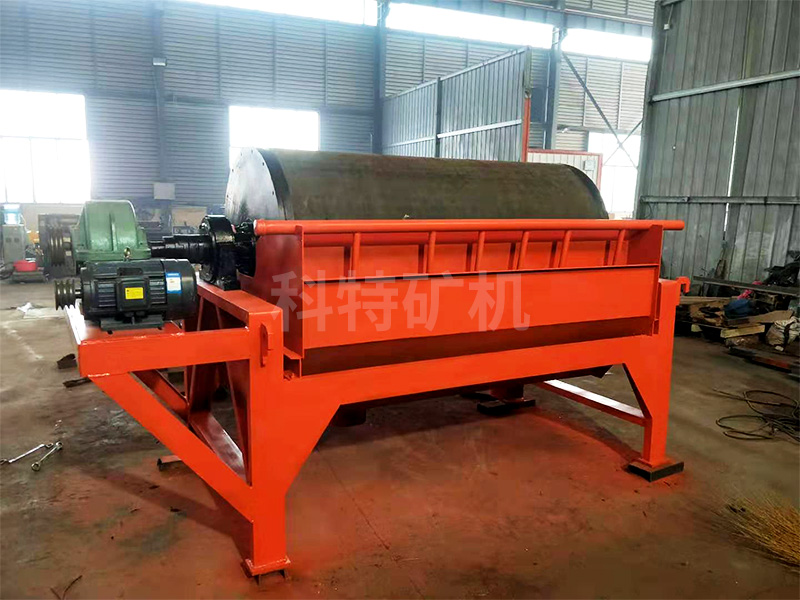What are the factors affecting the working efficiency of permanent magnet drum
 384
384 2019-07-20
2019-07-20

The permanent magnet drum is divided into fixed type and rotary type. The fixed type is mainly suitable for wet separation of fine magnetic substances in weak magnetic field or removal of strong magnetic minerals from non-magnetic minerals. When the slurry flows into the magnetic field area, the strong magnetic minerals are adsorbed on the cylinder surface, and the weak magnetic and non-magnetic minerals are removed after separation, The strong magnetic minerals adsorbed on the surface of the cylinder are brought out of the magnetic field with the rotation of the cylinder. The rotary type is suitable for the dry separation of fine-grained strong (medium strong) magnetic minerals. Due to the effect of high-speed rotation, the magnetic rollover times of magnetic particles are much higher than those of ordinary magnetic separators, which has a significant effect on ring breaking magnetic agglomeration and improving rich ore ratio. After separation, minerals are separated into magnetic and non-magnetic substances, which are discharged from their respective ore discharge ports, It is suitable for roughing and cleaning with ore particle size of 0.6-6mm. The same cylinder can be equipped with three kinds of tank bodies, namely, the sorting particle size of downstream tank is ≤ 6mm, the sorting particle size of countercurrent tank is ≤ 0.6mm, and the sorting particle size of semi countercurrent tank is ≤ 1mm.

There are many factors affecting the working efficiency of permanent magnet drum. In addition to the bottom box type, magnetic system structure and magnetic field characteristics, there are also magnetic system deflection angle, working gap, separation concentration and cylinder speed.
If the magnetic system deflection angle is not appropriate, it will obviously affect the sorting index. The so-called magnetic system deflection angle is the included angle between the center line of the magnetic system arc and the vertical line of the cylinder center. The tailings grade after magnetic system deviation is low, but when the magnetic system deviation is large, the tailings grade increases because the concentrate cannot be lifted to the concentrate end and fall off. If the magnetic system moves forward, the concentrate will be raised too high, the sweeping area will be shortened, and the tailings grade will be increased. Therefore, the magnetic system deviation angle should be adjusted to a moderate position. The distance between the surface of the rough selection cylinder and the bottom plate of the box is called the working gap. The size of working gap will affect the sorting effect. The large gap and the large flow of pulp are conducive to improving the treatment capacity. However, due to the distance from the cylinder surface and the low magnetic field strength, the tailings grade will be increased and the metal recovery will be reduced. On the contrary, if the working gap is small, increasing the magnetic field force will reduce the concentrate grade, but the recovery can be higher. If the working gap is too small, the slurry flow rate will be too fast, so that the ore particles will be brought to the tailings by the slurry flow before they can be sucked to the cylinder surface, which will increase the tailings grade and even make it difficult to discharge the tailings, resulting in the phenomenon of "full tank". Therefore, during the installation and maintenance of the magnetic separator, pay attention to ensure appropriate working clearance.
The separation concentration determines the pulp flow rate of a certain amount of ore and affects the separation time of ore particles. High concentration, slow flow rate, large resistance, gangue is easy to be mixed in the concentrate, reducing the quality of the concentrate. However, due to the long separation time, it is beneficial to the recovery rate. On the contrary, if the separation concentration is low, the concentrate grade can be higher, and the tailings grade will also increase, reducing the recovery rate. The cylinder speed also has an impact on the separation index, with low speed and low output. High rotating speed, large centrifugal force on ore particles, increased magnetic turnover per unit time, high concentrate grade and treatment capacity, and reduced recovery. In practice, it is very important to regulate the dispersion of water to the ore and the washing water of the concentrate. If the blown water is too large and the pulp flow rate is too fast, the tailings grade will increase. On the contrary, if the blown water is small, the ore particles will not be fully loose, which will affect the separation effect, increase the tailings grade and reduce the concentrate grade.


 Wechat scanning communication
Wechat scanning communication